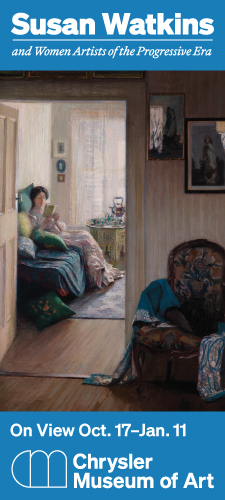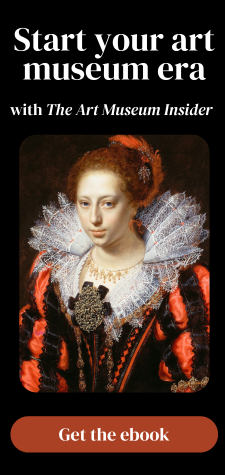Guest post by Lesley Stevenson, London Metropolitan University
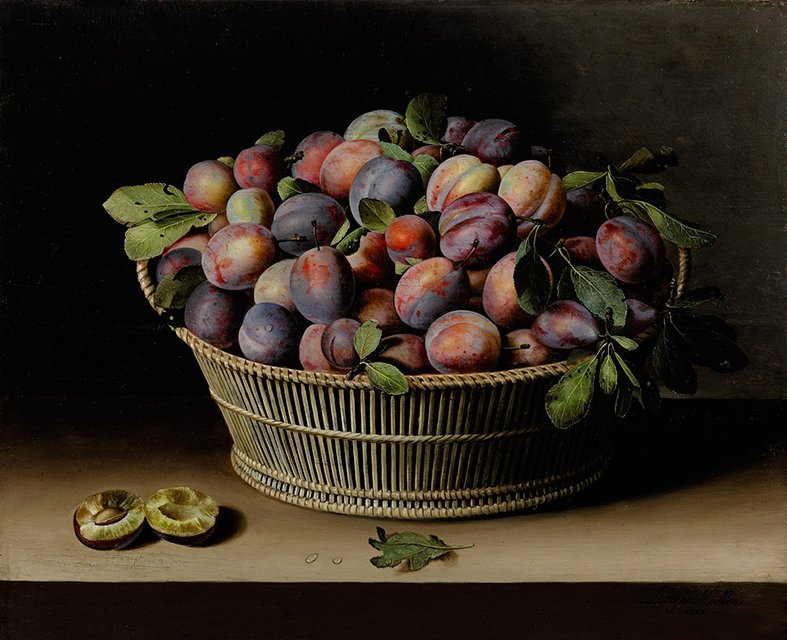
Lowizo de Molyne, Lousea Mullon, Loweza Mollon: who was Louise Moillon?
On the second floor of the Louvre Museum is a quiet room with a pair of remarkable still lifes. Their creator is one of France’s earliest women artists, the seventeenth-century painter Louise Moillon, who remains a mysterious presence. Several different spellings of her name exist: she signed her given name ‘Louyse’, but the inconsistency of seventeenth-century orthography offers many permutations of her family name: Lowizo de Molyne, Lousea Mullon, Loweza Mollon.
Louise Moillon is an attempt at art-historical detective work. The study pieces together the few tantalizing clues that exist in order to find out more about the artist and the context in which she was working, and to give her work the recognition its richly deserves.

A Dearth of Clues
The absence of important primary sources presents the first obstacle. Many of the archives held by the city of Paris that could have provided evidence—records of births, marriages and deaths—were destroyed by the revolutionary Commune in 1871. Therefore, much useful information is missing. Only a few legal documents associated with Moillon, mainly wills and some household inventories, remain.
Because there is no birth certificate or baptismal record for Moillon, the first mystery we encounter is when she was born. An approximate date has been calculated from the inventory of her father’s estate begun on 30 June 1620 (Nicolas Moillon had died the previous year), where her age was given as ten and a half. It has therefore become a convention that Louise Moillon was born in January 1610 or at the very end of 1609. The date of her death is more secure: either 20 or 21 December 1696, when she was 86 years old.
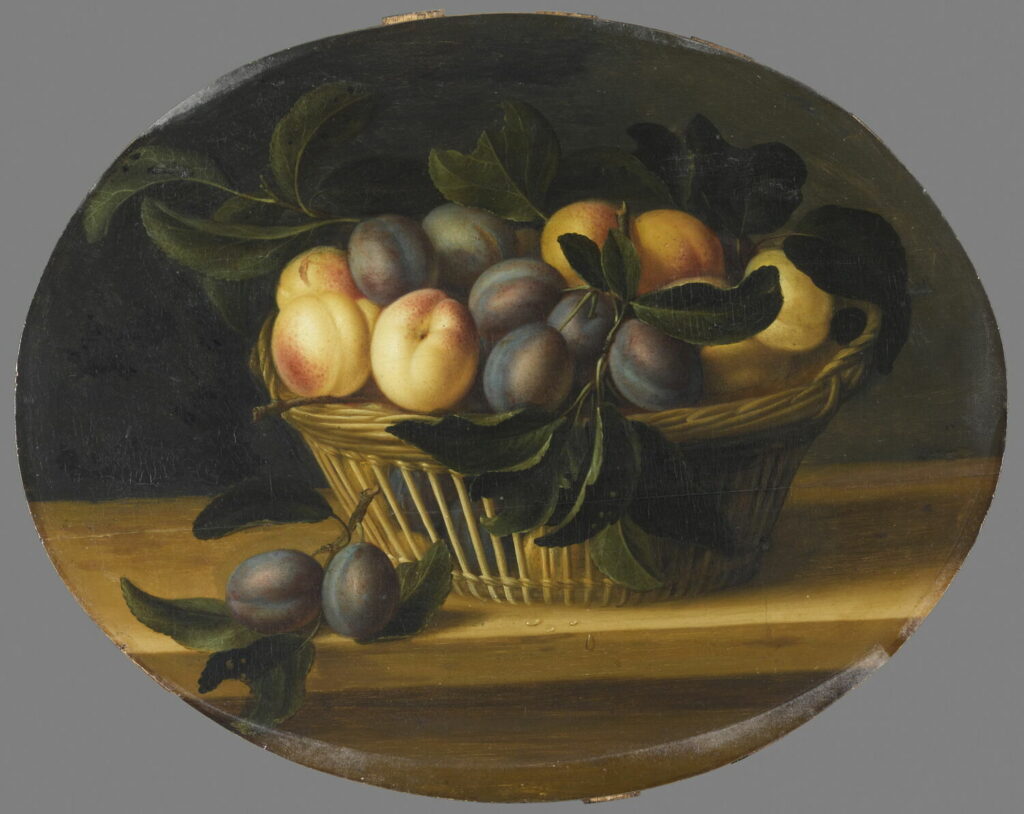
There is no evidence that Moillon ever left Paris. And yet, the artistic milieu in which she developed was incredibly fertile. She mixed with a number of other Protestant still-life painters, many of whom were religious refugees from Catholic Flanders living and working in the Saint-Germain-des-Prés area of the city. These newcomers worshipped at the Protestant Temple de Charenton alongside the Moillon family. So while she may not have travelled far, she was nonetheless exposed to important artistic influences at home.
Paris at Peace
What we do know is that Moillon was in many respects fortunate in coming to artistic maturity when she did. Despite being a Huguenot in a country that was predominantly Catholic, she was able to flourish during a brief interlude of religious tolerance between the Edict of Nantes of 1598, which recognized members of the Protestant faith, and the Revocation of the Edict in 1685, after which its members were once again subjected to persecution. She also profited from living and working in Paris in the first decades of the seventeenth century, as economic conditions improved with the end of the Wars of Religion between Huguenots and Roman Catholics.
Moillon’s early years coincided with a period of substantial rebuilding of the city, and the growth of a market for smaller, more intimate easel paintings for members of the mercantile, skilled artisanal class to which Moillon herself belonged. These patrons favored representations of everyday scenes and still life, a genre which was already well established by the beginning of the seventeenth century in the Netherlands, Flanders, Germany, Spain and Italy. The appeal of the genre had taken longer to develop in France because of the Wars of Religion and the resulting economic instability for middle-class patrons.
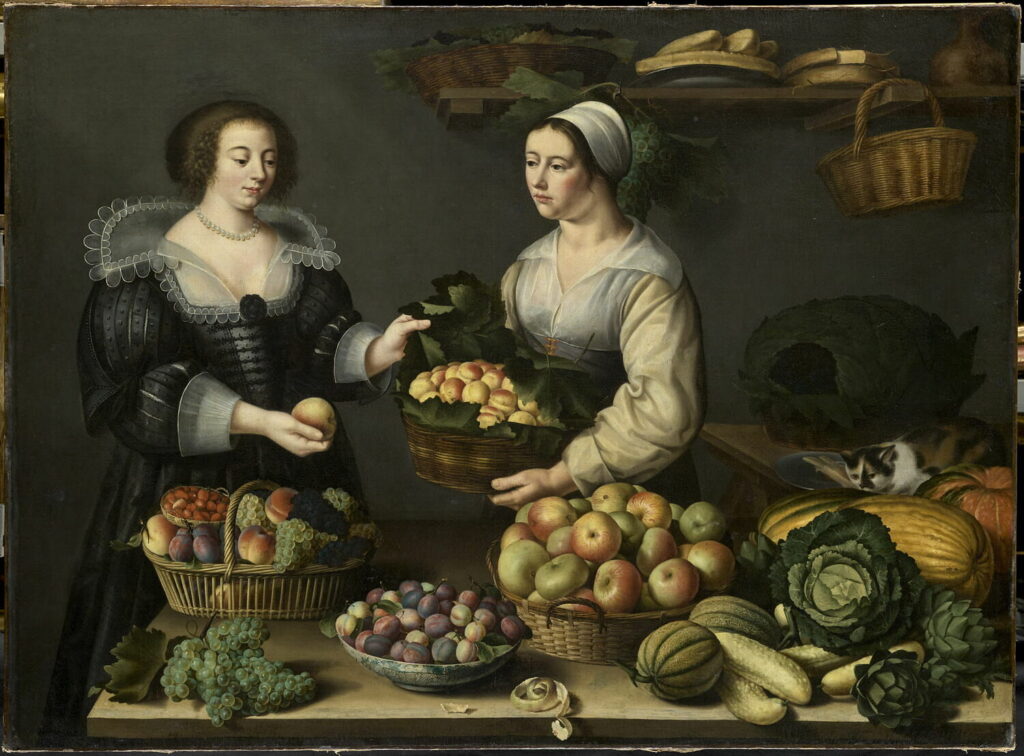
At the time, the markets in Paris produced plentiful motifs for the still-life painter. France was renowned for its pleasant climate, fertile soil and abundance of fruit and vegetables—which Moillon uses to great effect in The Greengrocer. An English traveller, Dr Martin Lister, visiting the city towards the end of the century, recorded in A Journey to Paris in the Year 1698 the profusion of fruit and vegetables found in the markets.
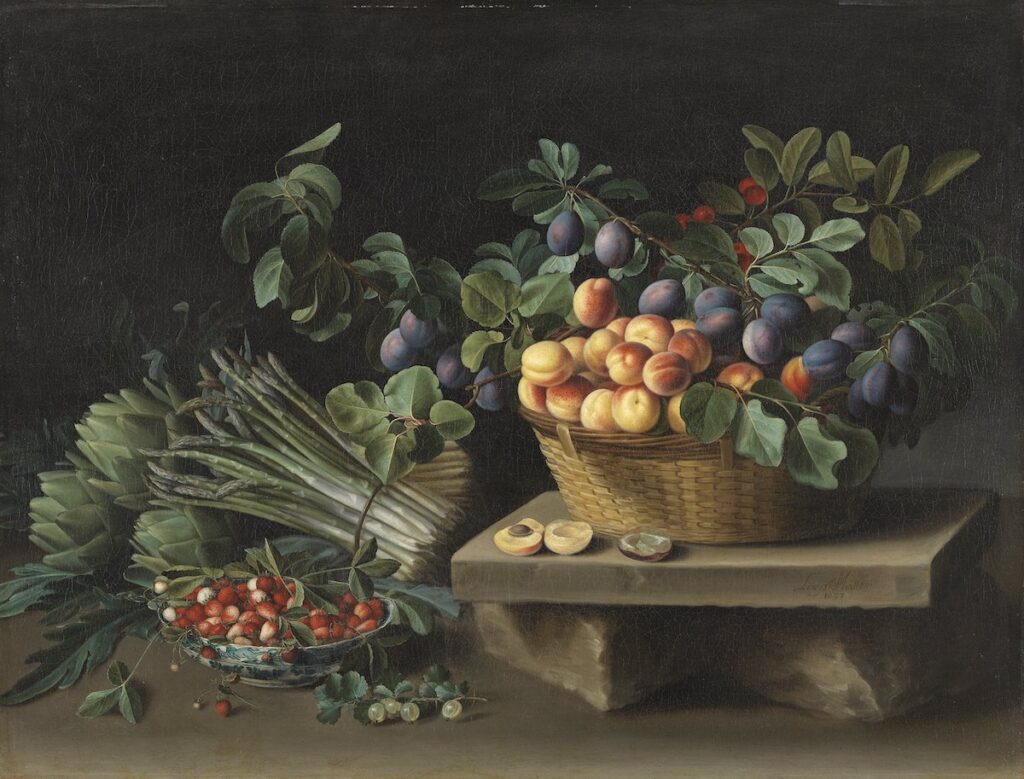
Apprenticeship
Moillon was also fortunate to receive her training before the foundation of the Académie royale in France in 1648. This institution would regulate the working practices of painters, especially women, often in quite restrictive ways. Instead, she was trained in a craft tradition which involved artisanal families working together, handing down traditional skills through the generations. The home was often the site of the familial workshop, where it was not unusual for women to contribute. After the death of Moillon’s father, her mother, Marie Gilbert, married the still-life painter François Garnier on 17 August 1620. An astonishing piece of evidence emerged ten years later, in 1630, in the posthumous inventory of her goods. The document records that by that date her daughter had produced at least 14 still lifes under her own name. It demonstrates that Garnier had selected Moillon as his de facto apprentice. A contract, drawn up at the time of her mother’s marriage, makes it clear that Moillon was to share the proceeds from the sales of paintings with her stepfather. That he had chosen to collaborate with her, rather than her brother Isaac, or her older sister, Marguerite, suggests that Moillon was already showing evidence of precocity at the age of only ten and a half.
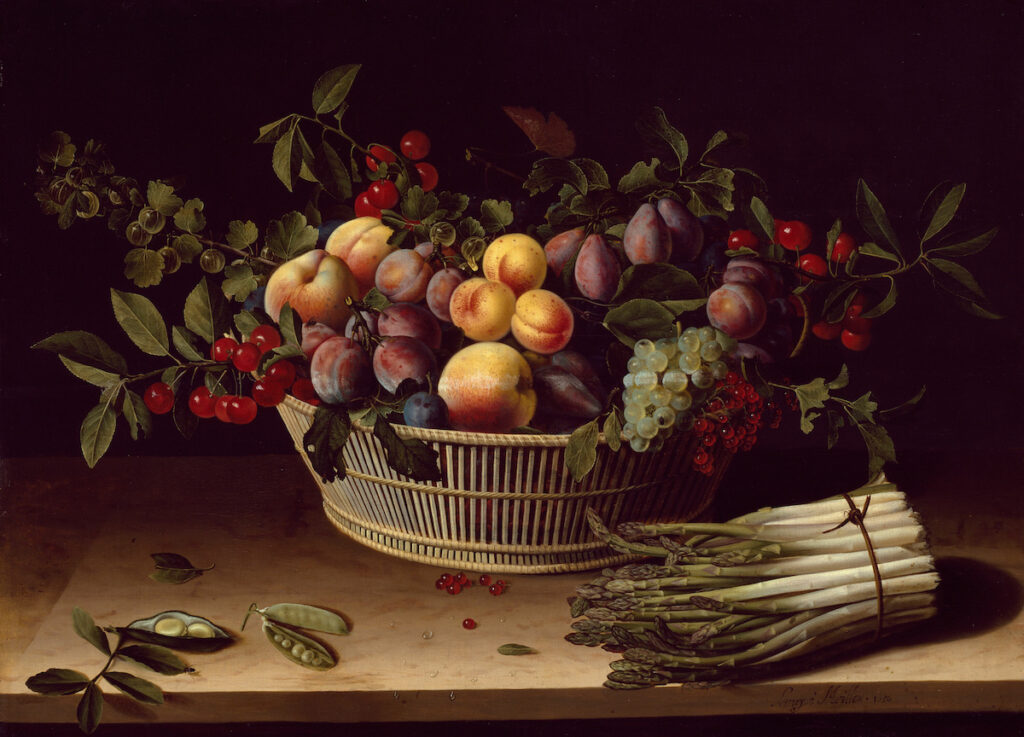
Collaboration with François Garnier
Still lifes from her early adulthood that Moillon signed and dated, such as Still Life with Basket of Fruit and Bunch of Asparagus or Still Life with Gooseberries, Strawberries and Cherries, both dated 1630, show clearly that by the age of twenty she was a confident, extremely talented painter.
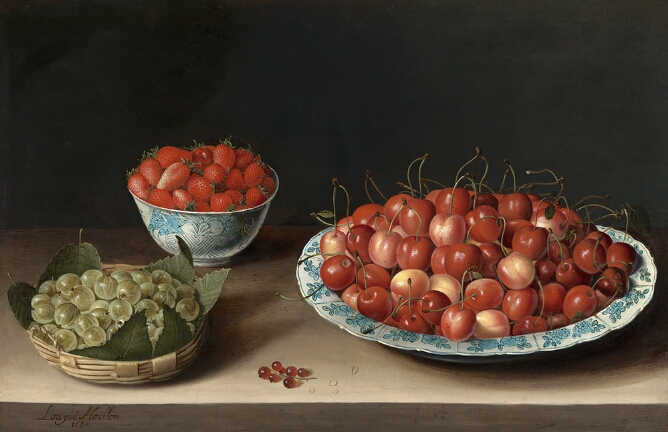
They also demonstrate that she claimed ownership of her work by signing it. Garnier did not attempt to impose his own signature. Few of his still lifes remain but, in the same room in the Louvre as the two paintings by Moillon, is Fruits on a Table: Gooseberries and Cherries, signed and dated as late as 1644. Something of the same respect for realism and interest in the fruit is evident in his work. However, Garnier’s fruit is laid out like horticultural specimens, whereas Moillon’s regard for the humblest of objects is evident in her handling and arrangement of the subject matter.

It is sometimes suggested that The Greengrocer might be a collaborative work by Garnier and Moillon, possibly with Garnier responsible for the figures and Moillon for the produce. Or perhaps The Greengrocer is a self-portrait, as is sometimes claimed? There is no evidence for this, but the young woman depicted in the fine clothing represents the social class to which Moillon belonged. Also, she is performing the kind of activity that would most likely have fallen to Louise after her mother’s death. The painting may mark a transition in domestic responsibility from mother to daughter.
Marriage, and the end of painting?
Why does the artist appear to have stopped painting around the time of her marriage in 1640 to Étienne Girardot de Chancourt? This is the biggest, unanswered mystery hanging over Moillon, which raises important questions about her work and the position of women artists in seventeenth-century Paris. It is tempting to assume that the abrupt cessation of output after such a successful and financially rewarding ten-year period must signal that her domestic duties prevented her from painting. Certainly it is difficult to find securely dated paintings by her after that time. Two of Moillon’s still lifes, from the Musée des Augustins in Toulouse, have dates which have now become almost impossible to decipher. It has sometimes been suggested that Basket of Plums and Small Basket of Strawberries could be dated 1672 or even 1682, as the third numeral is very faint.

But 1632 seems most likely to be date of the work, as there is no discernible change in style or subject matter to suggest that Moillon painted those works after comparable works with secure dates. Similarly, the date on the Basket of Apricots has occasionally been read as 1674; but on the balance of probability, 1634 seems more likely.
Early sources on Moillon claimed that she had children, but no substantial evidence supports this assertion. Crucially, the inventory of her husband’s estate after his death in 1680, and Moillon’s own last will and testament, written in 1686, make no mention of any offspring. Here, it is the absence of clues that provides the most compelling evidence that the marriage was childless, or that any children predeceased their parents.
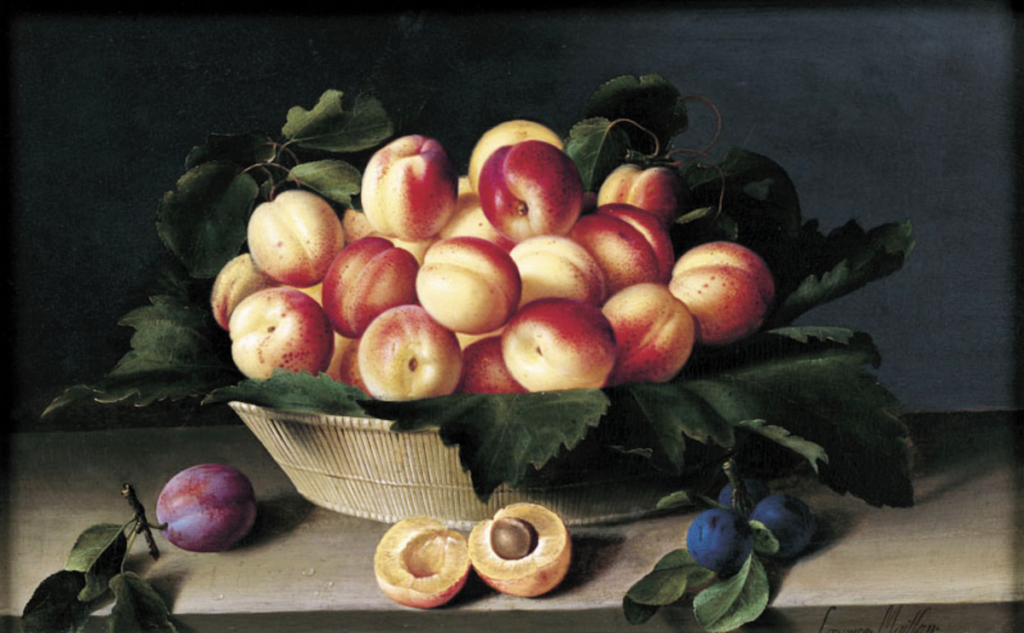
If domestic duties had cut Moillon’s professional practice short after a ten-year career, why is there little or no evidence that she resumed painting after her husband’s death? Here, we have to consider the changes in style that had taken place in the intervening years, and the changing demands of patrons. As a genre, still life had become much more decorative, often depicting luxury goods and handled in a way that would have been foreign to the simplicity and precision of Moillon’s style. Moreover, the Académie royale, founded in 1648, now exercised a much greater control over the lives of artists and their work. According to the academic tenet of the hierarchy of the genres, still life was now regarded as the lowest of the genres, imposing few intellectual demands and often amounting to little more than a kind of mechanical copying. Significantly, it was a genre which the Académie encouraged women artists to pursue.
Mysterious Simplicity
As evidence, the paintings themselves are of limited use; they reveal very little about Moillon or her practice. They include almost no people; they inevitably use the same standard location, with light falling from an unseen source from the left-hand side; they draw on a stock repertoire of fruit and vegetables. That is, they portray nothing that would not have been found in most homes in Paris at the time. Furniture, costly tableware, and fine linens are all absent; they betray no clues as to location or any significant domestic details. There is no sense in these works of food preparation or of meals being consumed. Nothing points to eating—drinking vessels, china, cutlery are absent.

Like so much else with Moillon, the available evidence only really reveals a further mystery: what did she not paint and why not? Why rely on soft summer fruits rather than the much more durable winter fruit and vegetables that Lister recorded? Why did she not paint flowers (a genre listed in the inventory of her father, Nicolas Moillon)? Why did her work avoid eucharistic symbols: bread, grapes or wine, fish? This set her apart from contemporary male still-life painters in the Saint-Germain-des-Prés group, who tended to favor the allegorical, emblematic still life. Instead, Moillon’s work marks a change in preferring everyday, domestic objects—and with a keen attention to detail. The defining characteristics of her paintings are different textures (bloom on plums, spiky artichokes, drops of dew), close observation, pared-back composition, and a minimum of objects gleaming against a gloomy background that fails to yield any answers.
Lesley Stevenson teaches in the School of Art, Architecture & Design at London Metropolitan University. She has been fascinated by the genre of still life since writing her PhD at the Courtauld Institute of Art on the critical reception to Cezanne’s still-life paintings. Her book Louise Moillon is co-published by Lund Humphries and Getty Publications in the series Illuminating Women Artists. She is currently working on a book on photography and still life.
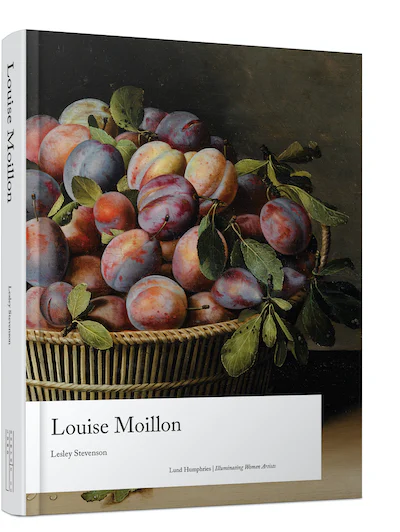
More Art Herstory posts about 17th-century women artists:
Historic Women Artists and Still Life at The Hyde Collection, by Erika Gaffney
Seductive Surfaces: Anne Vallayer-Coster’s Vase of Flowers and Conch Shell at the Met, by Kelsey Brosnan
Rachel Ruysch’s Vase of Flowers with an Ear of Corn, by Lizzie Marx
Women and the Art of Flower Painting, by Ariane van Suchtelen
Books, Blooms, Backer: The Life and Work of Catharina Backer, by Nina Reid
Floral Still Life, 1726—A Masterpiece by Rachel Ruysch, by Lawrence W. Nichols
Early Modern European Women Artists at the Montreal Museum of Fine Arts, by Erika Gaffney
Curiosity and the Caterpillar: Maria Sibylla Merian’s Artistic Entomology, by Kay Etheridge
Alida Withoos: Creator of beauty and of visual knowledge, by Catherine Powell
A Clara Peeters for the Mauritshuis, by Quentin Buvelot
Barbara Regina Dietzsch: Enlightened Flower Painter, by Andaleeb Badiee Banta
Madeleine Françoise Basseporte’s Hyacinths at the French Court, by Mary Creed
The Protofeminist Insects of Giovanna Garzoni and Maria Sibylla Merian, by Emma Steinkraus

